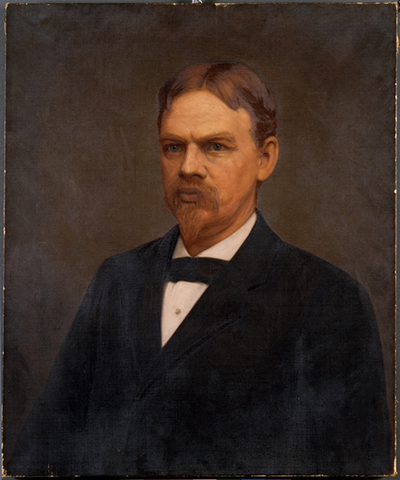Leroy Sunderland Buffington was born in Cincinnati, Ohio, on Sept. 22, 1847, and completed his schooling in that city, graduating from the University of Cincinnati in 1869. He trained to be a civil and mechanical engineer but found his true love was architecture. Buffington joined the architectural firm of Hannaford and Anderson, and then relocated to St. Paul in 1871 in search of greater opportunity. He spent a few years in St. Paul in partnership with local established architect Abraham Radcliffe, before moving to Minneapolis in 1874 to establish his own firm.
Buffington found quick success in Minneapolis and began to take on important commissions there, such as the Boston Block at Third Street and Nicollet Avenue, where he located his offices. Buffington was experimenting with iron and masonry construction by the late 1870s, which would prove significant in the next decade.The 1880s were extremely productive for Buffington. One of his major projects during these years was the Pillsbury A Mill, which was the first architect-designed mill. He also was the architect for the West Hotel, the second capitol building in St. Paul, and many buildings on the University of Minnesota’s Minneapolis and St. Paul campuses, including the Coliseum, Pillsbury Hall, and the Mechanic Arts Building, now known as Eddy Hall.

Buffington’s biggest, and most controversial, achievement of the 1880s was his “cloudscraper,” for which he received U.S. and international patents on May 22, 1888. He developed a detailed, fully realized plan for iron- or steel-skeleton construction used in conjunction with masonry to achieve building heights never before possible. These buildings are now known as skyscrapers.
Buffington published his ideas in respected architectural journals and was immediately mocked for them. However, buildings constructed using similar plans began rising in cities all over the United States. Buffington received no credit for these structures, so he formed the Buffington Iron Building Company and brought suit against many of the builders for patent infringement. The cases dragged on so long in court, however, that the patent rights expired. Buffington was then further mocked for spending $30,000 without winning a case in defense of his design.
![]() Respected architectural scholars argued publicly and passionately over Buffington’s claim to the skyscraper idea, but eventually the controversy died down without a clear resolution.
Respected architectural scholars argued publicly and passionately over Buffington’s claim to the skyscraper idea, but eventually the controversy died down without a clear resolution.
Buffington continued to work as an architect in Minneapolis into the twentieth century. After his wife’s death, he lived with his daughter at 35th Street and Aldrich Avenue South. On Feb. 16, 1931, he died in his sleep in Minneapolis, largely forgotten by the world beyond the Twin Cities, despite his earlier national fame.
For more information on this topic, check out the original entry on MNopedia.


0 Commentaires